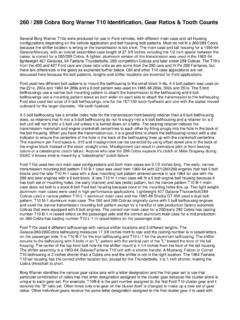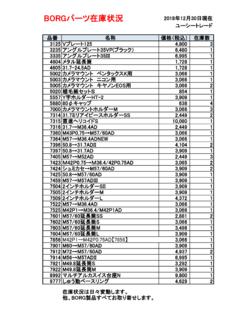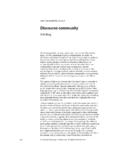Transcription of Identifying sets of key players in a social network
1 Comput Math Organiz Theor (2006) 12: 21 34 DOI sets of key players in a social networkStephen P. BorgattiC Springer Science+Business Media, LLC 2006 AbstractA procedure is described for finding sets of key players in a social network . Akey assumption is that the optimal selection of key players depends on what they are neededfor. Accordingly, two generic goals are articulated, called KPP-POS and KPP-NEG. KPP-POS is defined as the identification of key players for the purpose of optimally diffusingsomething through the network by using the key players as seeds. KPP-NEG is defined asthe identification of key players for the purpose of disrupting or fragmenting the network byremoving the key nodes. It is found that off-the-shelf centrality measures are not optimal forsolving either generic problem, and therefore new measures are networks Centrality Cohesion1.
2 IntroductionThe problem of Identifying key players in a social network is, at first glance at least, anold one. One stream of relevant research is node centrality ( , Bonacich, 1972; Freeman,1979), which attempts to quantify the structural importance of actors in a network . In addition,work on Identifying cores and peripheries ( , Seidman, 1983; Borgatti and Everett, 1999;Everett and Borgatti, 1999a) is relevant, as is work on group-level centrality (Everett andBorgatti, 1999b). Structural measures of social capital ( , Coleman, 1990; Burt, 1992;Borgatti, Jones and Everett, 1998) also tend to identify key players , although the perspectiveis reversed in that with social capital research one asks what features of the network contributeto the individual, whereas with key player research we ask which individuals are importantfor the , in this paper I attempt to show that existing measures and algorithms do notoptimally solve the key player problem as I define it, and that new approaches are approach I explore is based on measuring explicitly the contribution of a set of actors toS.
3 P. Borgatti ( )Department of Organization Studies, Boston CollegeE-mail: Math Organiz Theor (2006) 12: 21 34the cohesion of a network . In addition, I identify two separate conceptions or functions of keyplayers which reflect different analytical goals, and develop separate measures of suitabilityfor each type of goal. In this sense, I follow the problem-specific approach to centralityadvocated by Friedkin (1991).2. Defining the problemI argue that there are two fundamentally different aspects of the key player issue, reflectingdifferent kinds of purposes to which key player measurements and identifications are , there are two separate key player first key player problem is defined in terms of the extent to which the networkdepends on its key players to maintain its cohesiveness.
4 I refer to this as the Key PlayerProblem/Negative (KPP-Neg) because we measure importance in the breach the amountof reduction in cohesiveness of the network that would occur if the nodes were not arises in the public health context whenever we need to select a subset of populationmembers to immunize or quarantine in order to optimally contain an epidemic. In the militaryor criminal justice context the problem arises when we need to select a small number of playersin a criminal network to neutralize ( , by arresting, exposing or discrediting) in order tomaximally disrupt the network s ability to mount coordinated second key player problem is defined in terms of the extent to which key playersare connected to and embedded in the network around them. I refer to this as Key PlayerProblem/Positive (KPP-Pos).
5 A practical application in which KPP-Pos arises in a publichealth context is when a health agency needs to select a small set of population members to useas seeds for the diffusion of practices or attitudes that promote health, such as using bleach toclean needles in a population of drug addicts. Another application arises in an organizationalcontext when management wants to implement a change initiative and needs to get a smallset of informal leaders on board first, perhaps by running a weekend intervention with , the problem arises in a military or criminal justice context when one needs to selectan efficient set of actors to surveil, to turn (as into double-agents), or to feed misinformationto. In all these cases, we are looking for a set of network nodes that are optimally positionedto quickly diffuse information, attitudes, behaviors or goods and/or to quickly receive formal definition, then, of the key player problems is as follows.
6 Given a social network (represented as an undirected graph), find a set ofknodes (called a kp-set of orderk) such that,1. (KPP-Neg) Removing the kp-set would result in a residual network with the least (KPP-Pos) The kp-set is maximally connected to all other course, these introductory definitions leave out what is meant precisely by least possiblecohesion and maximally connected . Part of the process of solving these problems isproviding definitions of these concepts that lead to feasible solutions and useful , it can be said at the outset that KPP-Neg involves fragmenting a network intocomponents, or, failing that, making path lengths between nodes so large as to be practicallydisconnected. In contrast, KPP-Pos involves finding nodes that can reach as many remainingnodes as possible via direct links or perhaps short paths.
7 However, a goal of my approachis to construct generic solutions to each problem such that they can be used no matter howcohesion or connectedness is Math Organiz Theor (2006) 12: 21 3423 Fig. 1 Hypothetical network in which removing the most central node ( 1 ) does not fragment the networkAt first glance, both KPP-Neg and KPP-Pos would appear to be easily solved by selectingan appropriate measure of node centrality and selecting thekmost central nodes to populatethe kp-set. Alternatively, there are concepts in graph-theory that seem tailor-made for bothKPP-Neg and KPP-Pos. However, it turns out that, for both KPP-Neg and KPP-Pos, theseapproaches fail for two separate reasons, which I label the goal issue and the ensemble goal issue refers to the fact that centrality measures were not designed with KPP-Neg orKPP-Pos specifically in mind, and hence are not necessarily optimal solutions.
8 The ensembleissue refers to the fact that KPP-Neg and KPP-Pos are explicitly about selecting sets of nodesrather than individuals, and the optimal set for any task is not necessarily composed of thekmost-optimal individuals when considered the next two sections, I describe and address each The goal issueFor KPP-Neg, the most appropriate centrality measure would obviously be betweenness(Freeman, 1979). Freeman s betweenness measure sums the proportion of shortest paths fromone node to another that pass through a given node. Thus, a node with high betweenness isalong the shortest path between many pairs of nodes, and deleting that node should causemany pairs of nodes to become fully disconnected or at least more distantly , the optimality of betweenness in Identifying the node whose removal from thenetwork would most reduce cohesion is not guaranteed under typical definitions of the network in Fig.
9 1. Node 1 has the highest centrality on all standard measures,including betweenness centrality. Yet deleting node 1 has no effect on disconnecting thenetwork. Distances between nodes do increase somewhat, but if fragmentation is the goal,it is clear that removing node 1 is ineffective. In contrast, deleting node 8, which has lowercentrality on all measures, does disconnect the graph. Removing node 8 splits the graph intotwo large fragments ( , components).Whereas measures of centrality were not developed with problems like KPP-Pos andKPP-Neg in mind, a number of graph-theoretic concepts were. For example, much work hasbeen done on the vulnerability of graphs to disconnection, which relates directly to particular, there is the notion of a cutpoint, which is a node whose deletion would increaseSpringer24 Comput Math Organiz Theor (2006) 12: 21 34 Fig.
10 2 Hypothetical network inwhich the most central node ( 4 )does not reach the most numberof nodes in two steps or lessthe number of components in the graph. However, there are three difficulties with usingcutpoints in the KPP context. First, no account is taken of the size of components createdby the removal of a cutpoint. If removing the cutpoint merely isolates a single node, leavingall other nodes connected, this is not seen as better than removing a cutpoint which dividesthe network into two equal sized components. Second, if the graph contains no cutpoints,the concept provides no way of choosing a node whose deletion would nearly disconnectthe graph or which would make distances so long as to be practically disconnected. Third,cutpoints are a kind of discrete nominal classification rather than a measurement of the extentto which removing a node fragments a now to KPP-Pos, if we formulate the problem in terms of Identifying a node thatreaches the most nodes directly ( , paths of length 1), simple degree centrality is in factoptimal.





